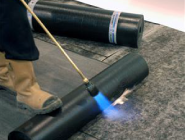Flat roofs are typically different to the average sloping roof by being horizontal or nearly horizontal. This means that the water will run off the roof from a very slight inclination. Modern flat roofs are usually made of continuous strips of membrane covering the entire surface. These are good at preventing pools of standing water, whereas old fashioned flat roofs will often be less effective.
Flat Roofing

More expensive flat roofs are made of metal such as copper or tin. If you do have an old fashioned flat roof, it may be sensible to renovate it – particularly if you are seeing signs of damp on the interior of your home.
Similar to tar and gravel roofing, the torch down roof consists of layers of fiberglass and polyester with bitumen that are added to the regular tar and gravel layering system. These extra sheets are torched down in the overlap areas during the installation process, using large flame throwing torches that melt the asphalt at the seams to join them together, which is the origin of the name “torch down roofing”. The final result is the vulcanization of a large rubber sheet onto a fiberglass base. Also called modified bitumen, due to the mixing of asphalt with rubber compounds, torch down roofing provides additional strength and resistance to a flat or low sloped roof. It is not, however, suited to areas prone to high rainfall or snowfall, and has an average life expectancy of about 15 years. A torch down roof is also significantly more attractive than a standard tar and gravel roof.
Benefits of Torch Down Roofing
The blend of synthetic rubberized polymers with asphalt makes torch down roofing extremely flexible. During climate change or extreme weather conditions, torch down roofing can shift as required and resist brittleness. Torch down roofing also provides excellent waterproofing and insulation qualities, and is a fire, wind, and hail rated roofing system.
